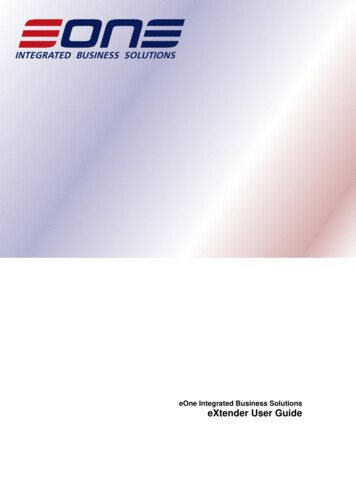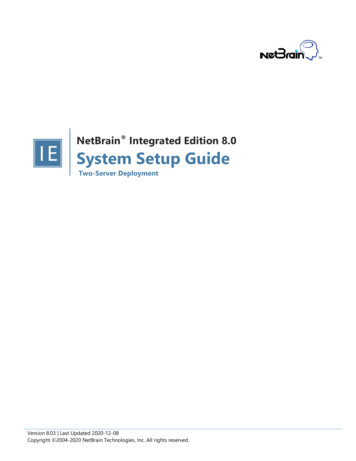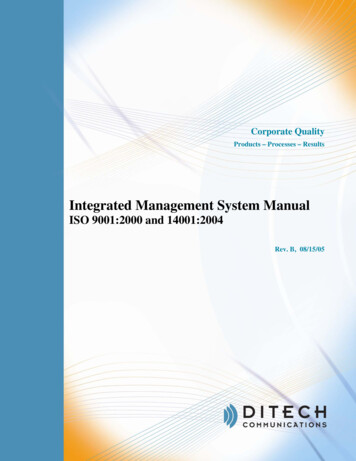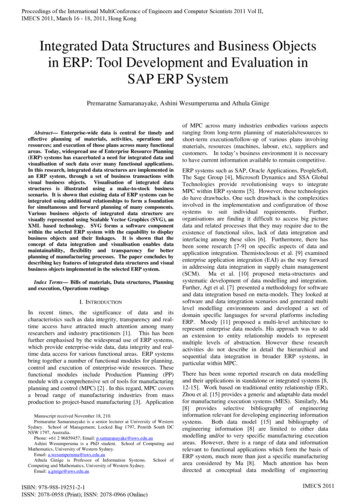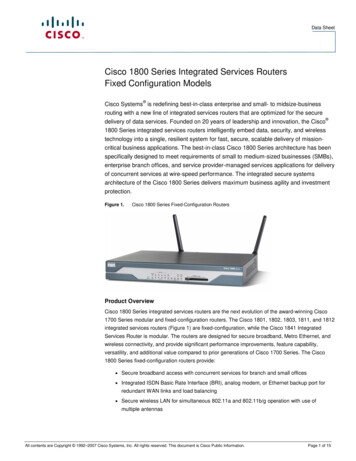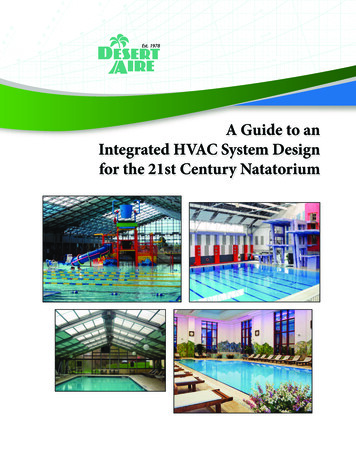
Transcription
A Guide to anIntegrated HVAC System Designfor the 21st Century Natatorium
ForewordContentsDesert Aire has written this document to provide owners,mechanical contractors and engineers with a helpful guideto designing or retrofitting an indoor pool facility.Overview . 3 e Purpose of the Natatorium e Goals of HVAC DesignJust in the past few years there has been a major breakthrough in understanding the complexity of maintainingthe indoor air quality of a pool facility. is guide tries totie together the many independent elements of a very complexHVAC system, building structure, water loop, facilityprogramming and energy consumption. For too long theseelements were designed independently and rarely was aneffort made to integrate them to create the best indoor poolfor all stakeholders.It is our expectation that this guide will assist in developingthe dialog to solve problems in existing designs as well asserve as the benchmark for new construction. e guidewill also refer to other documents or industry knowledgeto support creation of final design specifications and theconstruction document.This guide will be a living document so we welcome theopportunity to receive your feedback on innovations andinnovative thinking that can help produce the highestquality indoor pool facility. Feel free to reach out to anyDesert Aire sales representative or staff member with yourfeedback.Keith CoursinPresidentDesert Aire Corp.Keith@desert-aire.comHeating, Cooling and Moisture LoadDetermination . 4 Air and water temperatures Relative humidity Airflow across water Activity factor Spectator load Ventilation loadCondensation and Building Integrity . 7 Dew point control Vapor barrier Negative pressure Spectator areasSwimmer Health Concerns . 11 Toxic air Most common airborne contaminants Source capture solution Pool chemical usage Chlorine Chlorine alternatives Salt water poolsProper Airflow Design . 13 Duct design Supply air rateDehumidification Equipment DesignConsiderations . 15 Dehumidifier system components Dehumidifier design options Economizers Purge mode Maximizing energy recovery Integrated with source capture Low exhaust energy recovery Installation considerationsCommissioning . 22 Factory certified start-up Facility staff trainingConclusions . 22
3A Guide to anIntegrated HVAC System Designfor the 21st Century NatatoriumOverviewThe Purpose of the Natatorium e natatorium is a building that contains one or moreaquatic venues and structures where the general public isexposed to water intended for recreational or therapeutic use.Although we most o en think of aquatic venues as indoorpool facilities for swimming and diving, they may not onlycontain standing water. The term can be used to describeindoor water parks where the public is exposed to water bycontact or spraying, such as with waterslide landing poolsand spray pads.A natatorium can be housed in a dedicated building or nondedicated building such as a school building or fitness club. e natatorium may also house locker rooms, lavatories andoffices. Locker rooms, staff offices and storage rooms shouldnot be part of the pool room mechanical HVAC system. is design guide focuses on larger natatoriums and aquaticcenters but many of the concepts would apply to smallercommercial and residential indoor pool facilities.The Goals of HVAC Design e many ways people use buildings with enclosed pools forrecreational, competitive and health purposes continue toevolve. ese uses place demands on HVAC systems and on thebuildings themselves that weren’t present even a generationago. Fortunately, there are advances in knowledge, understanding, strategies and technology that meet the challengesof today’s natatorium.Reflecting the depth and breadth of demands, the scope ofHVAC design considerations for large natatoriums andaquatic centers has expanded in the 21st Century.Objectives now include protecting the health of swimmers,divers, coaches and spectators; promoting the long-termstructural integrity of the building and supporting systems;and conserving energy, water and water treatment resources.But there is a guiding principle that applies to HVAC systemdesign no matter the purpose, size and location of thenatatorium: the HVAC system must work in harmony withsystems that control water temperature and water quality.For engineers who must translate these objectives intodesign goals an integrated, sustainable approach is required.These design goals must reconcile the intensive tasks ofdehumidifying the space, heating and cooling the interior,heating pool water, and meeting outdoor air requirements.Fortunately, today’s design engineers have access to a rangeof problem-solving equipment technologies and strategies. ese technologies and strategies complement resourcesmade available by professional associations and engineeringsocieties; and the goals manifest in building codes andstandards. For example, the American Society of Heating,Refrigerating and Air-Conditioning Engineers, Inc. (ASHRAE)provides guidance and resources for pool room design. e Model Aquatic Health Code (MAHC), published by theCenters for Disease Control and Prevention (CDC), is amore recent addition to the resources available to mechanicalengineers.First published in late 2014, the MAHC is a set of guidelinesfor public aquatic facilities. According to the CDC, theMAHC “brings together the latest knowledge based onscience and best practices to help state and local governmentofficials develop pool codes. Pool codes are specific rules thatdesigners, builders, and managers of spas, pools, waterparks,and interactive fountains must follow to keep the fun goingand reduce injuries and illnesses.”
4 e MAHC encompasses traditional aquatic venues such asthose enclosing swimming pools and spas. e MAHC alsocovers contemporary water-containing structures includingwave pools, surf pools, therapy pools and spray pads.As part of bringing together the best knowledge and practices,the MAHC states the design, construction and installationof indoor aquatic facility air handling systems shall complywith local codes as well as the proven ASHRAE standard62.1 2013, Ventilation for Acceptable Indoor Air Quality.Together, this matrix of technologies and strategies providesmechanical engineers with essential tools for balancingdiverse operating conditions, seasonal variations and specialevent needs with building codes and standards for theongoing, critical concerns of indoor air quality and relativehumidity.Heating, Cooling and MoistureLoad Determination e heating, cooling and moisture loads of a natatorium area product of seasonal variations in outdoor air temperatureand humidity, solar gains and losses as well as the presenceof spectators and bleacher areas. The heating load is the amount ofheat energy that must be added to thenatatorium to achieve or maintain atarget temperature level. This is oftenconsidered the heat loss calculation andis a dominant factor due to the highinternal design temperature of an indoorpool area. The cooling load is the amount of heatenergy that needs to be removed toattain the target temperature. is is theheat gain calculation with solar gain andlighting heat being the most significantportions of this load. e moisture load is the amount of moisture that needsto be removed to attain a target relative humidity level.The moisture load has three components: evaporationfrom the water surface; moisture content from theventilation air; and evaporation from spectators.To calculate heating, cooling and moisture loads to specify andsize HVAC equipment, these loads are expressed as sensibleand latent. Sensible heat and loads are the heat swimmersand building users feel on their bodies and are temperaturesthat can be measured by a thermometer. Latent heat andloads are the energy and heat stored in humidity, a productof its change in state from liquid to gaseous. These twocomponents when combined provide the total system ratingthat the HVAC equipment must be designed to remove. e overarching goal in managing heating, cooling andmoisture loads is sustainability: ensuring the natatorium cancontinue to fulfill the purposes for which it was built ina safe and cost-effective manner. Related HVAC designconsiderations, as stated earlier, are protecting the health ofswimmers, divers, coaches and spectators; promoting thelong-term structural integrity of the building and supportingsystems; and conserving energy, water and water treatmentresources. e ASHRAE Applications Handbook provides formulas forcalculating the natatorium moisture load. e factors thatare used in those formulas include the air and water temperatures, relative humidity, airflow rate across the water, activityfactor, spectator load, and the ventilation load. Each of thosewill be discussed below.Figure 1. A pool room with an overwhelmed HVAC system.A pool room that does not maintain the proper temperatureof its air and pool water along with setting the correct relativehumidity range can quickly overwhelm even the best HVACequipment.
5Air and Water TemperaturesRelative Humidity ere are many combinations of air and water temperaturesbeing utilized in pool facilities and no one condition is morecorrect than the other. erefore the owner must make adecision on what air and water setpoints they will use intheir facility as this will be a key factor in dehumidifierselection. Changing design conditions after the HVACsystems are installed may not be possible.As the equipment centerpiece of natatorium HVAC systems,the dehumidifier controls humidity in pool enclosuresto counter what is created by evaporation, regardless ofoutdoor conditions. is improves indoor air quality andthe comfort of swimmers and occupants. Humidity controlalso protects building structural elements, furnishings, andsupport systems such as lighting.ASHRAE recommends maintaining the natatorium airtemperature at two to four degrees above the pool watertemperature but not above the comfort threshold of 86⁰F. ere are several reasons for this recommendation. is isan effort to create a design condition that seeks a balance inthe overall dehumidifier sizing and the energy costs associatedwith maintaining the conditions in the space and pool water.In addition, the warmer air temperature will help make theswimmers not feel as cold when leaving a pool.ASHRAE recommends that the relative humidity in anatatorium be maintained between 50% to 60% relativehumidity. Lower relative humidity increases operation costsdue to increased evaporation and it can lead to swimmerdiscomfort due to evaporative cooling from their bodieswhen exiting the pool. Higher relative humidity increasesthe risk to the building structure.However, recent changes in the average water temperatureof an indoor pool can make it difficult to maintain the airtemperature higher than the pool water temperature. Ananalysis of commercial pools found that the average poolwater temperature had increased from 82⁰F to 86⁰F between2003 and 2013 due to the prevalence of swim lessons servingthose 10-years-old and younger and vertical swim classes forsenior citizens; both of these swimmer groups desire warmerwater temperatures than recreational or competitive swimmers.One of the recent changes in natatorium design is movingaway from designing ductwork to have grilles aimed at thepool water surface. It is now recommended that air be pulledacross the pool water surface at less than 30 feet per minute.All of the air supply should be aimed at exterior walls andwindows and not at the pool. The reasons for this arediscussed in the Source Capture Solution section of this guide.It is very important when designing a dehumidificationsystem for a new or remodeled facility that the pool ownercommunicates to the engineer the desired operating setpoints. Similarly, it is important the engineer communicateto the pool operator the importance of maintaining conditionsin the natatorium and adhering to design set points.A 3,500 square foot natatorium, designed for 82⁰F poolwater temperature and 84⁰F air temperature will havean evaporation rate of approximately 159 lbs/hr at 55%relative humidity. Raising the water temperature to 86⁰Fand keeping all other factors the same will increase theevaporation rate by 33% to 211 lbs/hr. e dehumidificationsystem designed for the lower water temperature will nowbe significantly undersized to handle the larger load of thewarmer pool water. As mentioned earlier, communicationbetween the engineer and the pool operator is essential whendesigning for a specific evaporative load.Airflow Across WaterThe ASHRAE formula for the evaporation load of a poolassumes that the air will not exceed 30 fpm. Using the samepool as mentioned above (3,500 sq. . at 82⁰F water and 84⁰Fair) and increasing the airflow across the pool water from 30fpm to 125 fpm will increase the evaporative load by 40%.If the design engineer for that pool uses the standardASHRAE formula for computing the evaporative load buthas air supplied directly across the pool surface, then thedehumidification equipment selected will most likely besubstantially under designed.
6Activity FactorAnother factor in the formula for finding the natatoriumevaporative load that an engineer needs to consider is thepool usage. e ASHRAE formula gives an activity factorbased on the type of pool, ranging from an unoccupiedbaseline for any pool of 0.5 up to an activity factor of 2 orgreater for a water park. Different activity factors are givenfor condominiums, therapy pools, hotels, public pools,
pool facilities for swimming and diving, they may not only contain standing water. The term can be used to describe indoor water parks where the public is exposed to water by contact or spraying, such as with waterslide landing pools and spray pads. A natatorium can be housed in a dedicated building or non-dedicated building such as a school building or fitness club. e natatorium may also .

